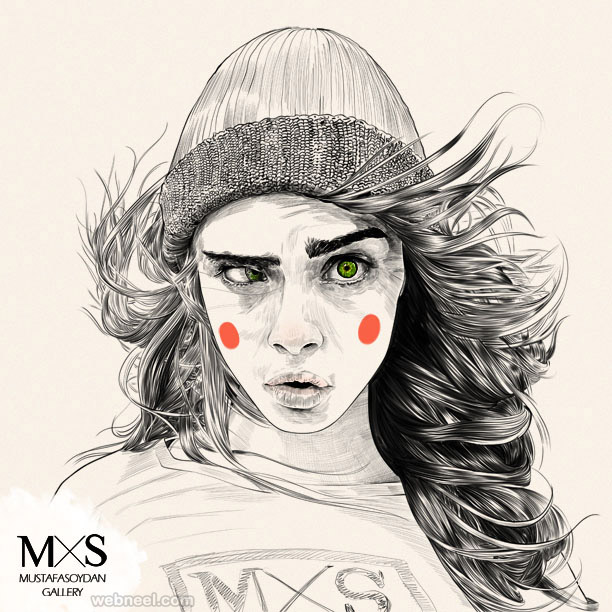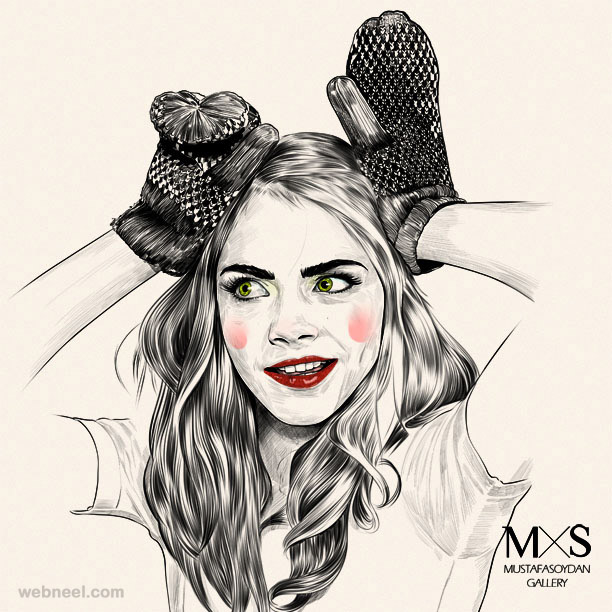Illustration
Illustration ( from Lat illustrare " enlighten, explain, praise "; Pl illustrations ) means " an explanatory text accompanying illustration ", regardless of its form or specific function.
With illustration is metaphorically but also the process of linguistic explanation, so that Illustrate and making understandable a situation referred to.
History
Already found in ancient scrolls and codices themselves - albeit rarely - Illustrations ( see Book Illustration of antiquity ).
In the Middle Ages, that is, before the invention of printing and the consequent possible technical reproduction, in manuscripts, then, were as illustrations - painted book miniatures used for example in the form of initials - this is called "Illumination " or " Illumination ". After Gutenberg were usually - analogous to the pressure of the text in moveable type - used woodcuts, which were also hand colored in certain cases.
An important illustration for the art historical phase was the Reformation. It led to a peak in the wide distribution of leaflets, often even to text largely dispensed with mass production; the audience was illiterate in general.
The woodcut method was replaced about 1600 by the Copper engraving, this will be replaced in the coming centuries by numerous other techniques - to the perfect modern color printing. Especially the xylograph ( = Wood engraving unlike the woodcut) was in the 19th century the dominant Illustration art books. Later developed by Senefelder in Munich technique of lithography came to him ( = stone pressure).
With the advent of photography pushed the graphical illustration in the background. The explanatory Illustration contrast, developed for information graphics.
Use
Scientific Illustration
Illustrations in scientific textbooks are added since the early modern texts, which can be unique only convey in pictures, for example anatomical images, in so-called " herbals " or technical descriptions. A special importance was the illustration here by the researches of the Académie under Colbert. Based on this tradition, the encyclopedist Diderot and d' Alembert support under the didactic effect of the picture and put it for the first time in a large scale ( Technique: etching ).
A form of scientific illustration is the " paleoart " ( the English term was coined by Mark Hallett ). Paleoart can, however, be carried out not only as a two-dimensional illustration, but also as a three-dimensional sculpture or sculpture, for example, by Heinrich Harder ( 1858-1935 ). The Society of Vertebrate Paleontology since 1999 gives the John J. Lanz village paleoart Prize for particularly worthy paleoart.
- Important members: Robert T. Bakker, Zdeněk Burian, Gerhard Heilmann, Doug Henderson, Charles R. Knight, Gregory S. Paul, Rudolph F. Zallinger
Literature Illustration
The development of literature illustration is Culture History important since the 18th century. Increasingly was the readership of the bourgeois age on addition of images, and so a large number of artists in the sector of art history have created important works.
- Important representatives: Daniel Chodowiecke (including Lessing and Goethe ), Bonaventura Genelli and John Flaxman (including Homer ), Moritz Retzsch (including to Goethe's Faust ), Johann Christian Ruhl (including Gottfried August Bürger and Ossian ), Julius Nisle ( among other things, to Johann Peter Hebel ), Peter Cornelius (including Goethe's Faust ), Julius Schnorr von Carol field (including the Bible ), Eugène Delacroix (including Shakespeare's Hamlet), Gustave Doré (including Dante, John Milton, Cervantes, and Charles Perrault, all in German translation ), Wilhelm von Kaulbach (including Goethe's Reineke Fuchs), Ludwig Richter (including Ludwig Bechstein's Fairy Tales ).
Of particular importance then won the literature illustration in the movement of the "Arts and Crafts " in England from the mid-19th century. A fundamental reconsideration of craftsmanship solidity and simultaneous beauty of all commodities, that is especially true of the book, suggested between William Morris and Aubrey Beardsley to a veritable renaissance of book illustration in the early modern period, - that is, especially in the so-called " type Nouveau "and its German variant, the " Art Nouveau ", or the Vienna Secession.
- Important members: Maurice Boutet de Monvel, Eugène Grasset, Gaston de Latenay, Alfons Mucha, Lajos Kozma, Fidus, Franz Stassen, Emil Preetorius, Alfred Kubin, Karl Rössing, Berthold Löffler, Olaf Gulbransson, Thomas Theodor Heine, Melchior Lechter, Ignatius Taschner Marcus Behmer, Albert Weisgerber, Félix Vallotton, Heinrich Vogeler, Heinrich Lefler, Czeschka, Franz Wacik, Ivan Bilibin, Walter Crane, Joseph of Diveky, Koloman Moser, Arthur Rackham, Maxfield Parrish, Edmond Dulac, Harry Clarke, Else Wenz - Vietor, Ruth Koser - Michaels.
Also from numerous neighboring areas, the cartoon or the cartoon were strong influences in the literature illustration.
- Important members: Albert Dubout, A. Paul Weber, Robert Högfeldt, Paul Flora, Kurt Halbritter, Guillermo Mordillo, Edward Gorey, Walter Moers, Brian Bagnall, Wilhelm Maier- Solgk.
The still remains since the early modern interesting and innovative division of literature illustration is the picture book and children's book. There she is playing an ever greater role.
- Important representatives: Alan Aldridge, Carl buses, Etienne Delessert, Maurice Sendak, Eric Carle, Wolf Erlbruch, Sabine Friedrichson, Mario Grasso, Janosch, Eva Johanna Rubin, Rotraut Susanne Berner, Jutta Bauer, Lisbeth Zwerger, Luis Murschetz, Friedrich Karl Waechter, Renate Seelig, Byron W. Sewell, Nicholas Heidel Bach, Roberto Innocenti, Jacky Gleich, Gennady Spirin, Hans de Beer, Marcus Pfister, Rene Borst
In adult fiction, she was cared about in the GDR or the Books Gutenberg in Frankfurt.
- Important members: Max Schwimmer, Werner Klemke, Hans Ticha, Klaus Ensikat, Michael Mathias Prechtl, Bernard Hunter, Kay Voigt, Hans Traxler
Illustration in the history of art
Like no other spiritual science is the history of art forced to rely on research and the mediation of own teaching object on pictures. Even in its early days she sat in manuals and survey works on this didactic means. Although innovations such as photography, transparency and the " new media" are controversial in their influence on the tray. The media presence but that is subject to this field at all, is still mostly out in the cold.
Commercial Illustration
In the last 50 years who took "commercial illustration " much more important to, notably in advertising and packaging of products. This illustration is used to make the viewer a quickly understandable visualization of information accessible to the supplement to the text in the classical sense " illustrate " ( " light up " in terms of " non-textual information available to make " ) to. Examples include manuals and exploded views. Gern illustrations also be used for placement of " Moods " (emotions ) that the advertised product a poorly transmittable through textual information connotations or emotionally charged mood status ( for example, a " nostalgic ", " modern " or " aggressive" mood ).
Illustration was and is also used in the (advertising) film making and sketching so-called " layouts " so that in the first phase of the presentation of a campaign for a client by graphic visualizations no photographs must be used, as in the production of which to be used means, the costs would be quite a bit higher than they are by a few drawings. These forms of illustration not reach the public (so-called " Below the Line " illustration ). Public are promotional illustrations that appear in print, whether as a Poster, as a display subject or as a moving image in the animation.
Editorial Illustration
Another area is that of the " editorial " used illustration: in newspapers and magazines about, and recently also on websites.
Figure legend
In a figure legend should be annotated with short and precise captions the image content as well be called the author. To avoid confusion, images, and graphics, are numbered. Possibly. this is only chapter by chapter. In a single work, the sequence of recurring information should be identical in the legends; eg Abbi.Nr., author, year, size ( WxH SI unit ), Title. A further description follows in the next, indented line, single line spacing. For the understanding of the text, it would be better if this is done in the text. Figures should represent a gain in information and be anchored by references in the original text.
Publishers have very often their own guidelines for authors, where further information about image quality, size, labeling, and transmission may be included.










